Scottish greenhouse gas emissions: 1990-2015
This publication provides estimates of greenhouse gas emissions in Scotland for the years 1990 to 2015.
This document is part of a collection
Section D. Revisions to the Inventory and Methodology
This section examines key revisions in estimated source emissions between the latest inventory (1990-2015) and the previous inventory (1990-2014) published in June 2016. It also provides a summary of the cumulative impact of revisions since the 1990-2008 inventory. In October 2015, the Scottish Government published a paper Scottish Greenhouse Gas Emissions 2013. Key Revisions Since 2008, which provides a breakdown of the key revisions to the data within the Scottish Greenhouse Gas Emissions Official Statistics publication over successive years from the 1990-2008 inventory to the 1990-2013 inventory. This section of the publication is intended to build on this revisions paper.
Compilation of the Greenhouse Gas Inventory
The greenhouse gas inventory covers a wide variety of anthropogenic sources of greenhouse gas emissions. There is therefore a wide variety of emissions sources which require different approaches to their estimation. There are a large number of data sources used in its compilation, obtained from Government statistics, regulatory agencies, trade associations, individual companies, surveys and censuses. The methods used to compile the greenhouse gas inventory are consistent with international guidance on national inventory reporting from the Intergovernmental Panel on Climate Change.
Most emission estimates are compiled by combining activity data (such as fuel use) with a suitable emission factor (such as amount of CO 2 emitted per unit of fuel used). Estimates of emissions from the industrial sector are often compiled based on plant-specific emissions data. Emissions from some sectors are based on more complicated models - such as the model used to estimate emissions from landfill, and the model used to estimate the carbon dynamics in soils when trees are planted. Much of the data on net emissions from agriculture and related land use, land use change and forestry emissions are based on modelled data for Scotland, which are consistent with, but not constrained to, the UK totals and thus are known as "bottom up" estimates.
Many of the remaining emissions sources within the inventory have been collated on a "top down" approach where estimates of emissions have been apportioned to Scotland using proportions of energy use in the Department of Business, Energy and Industrial Strategy ( BEIS) Publication "Digest of UK Energy Statistics ( DUKES)". This approach is prompted by data availability on emissions being more limited at the sub- UK level.
Impact of Revisions
Revisions between the 1990-2014 and 1990-2015 inventories
Charts D1 to D3 and Table D1 illustrate the impacts of revisions between the 1990-2014 and 1990-2015 inventories, both by sector and by greenhouse gas. This is followed by a discussion of the reasons for the key revisions.
Chart D1. Scottish Greenhouse Gas Emissions. Comparison of 1990-2014 and 1990-2015 Inventories. Values in MtCO 2e
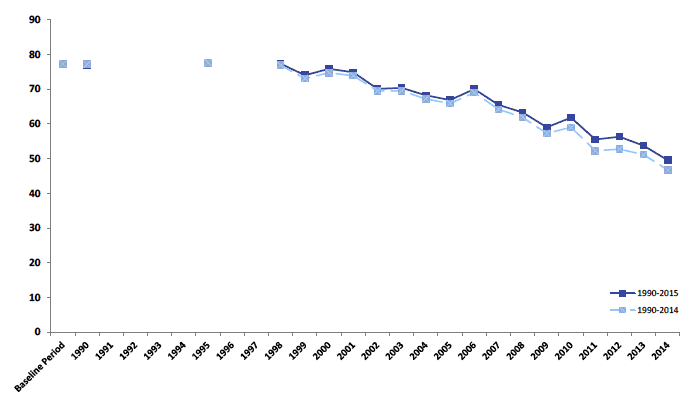
Chart D2 shows that the main downward revision to the Baseline period occurred in the Waste Management sector (revised downwards by 4.2 MtCO 2e). Forestry and Agriculture and Related Land Use saw an upward revision to the Baseline period (3.5 MtCO 2e and 0.3 MtCO 2e respectively). Other sectors saw very little change between the 1990-2014 and 1990-2015 inventories, with a slight (0.1 MtCO 2e) increase in emissions from Residential.
Chart D2. Revisions to emissions in the Baseline Period, from the 1990-2014 inventory to the 1990-2015 inventory, by source sector. Values in MtCO 2e, and percentage changes
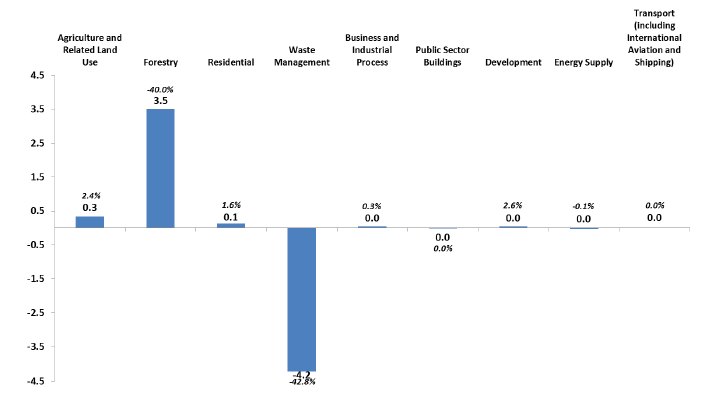
Chart D3 shows that the greatest downwards revision in 2015 occurred in the Waste Management sector (0.8 MtCO 2e). The greatest upwards revision occurred in forestry (2.9 MtCO 2e).
Chart D3. Revisions to emissions in 2014, from the 1990-2014 inventory to the 1990-2015 inventory, by source sector. Values in MtCO 2e, and percentage changes
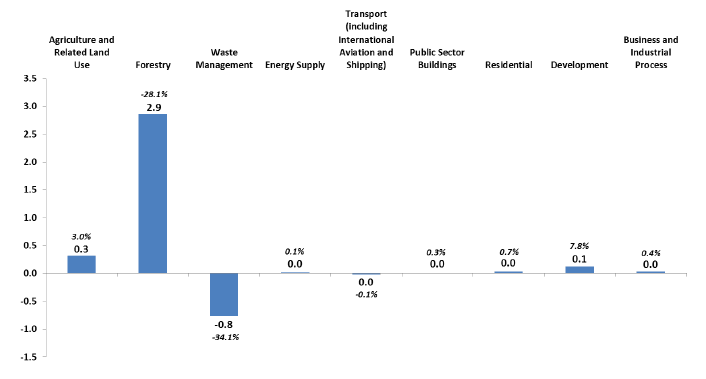
Table D1. Changes in emissions by source sector. Comparison of 1990-2014 and 1990-2015 inventories. Values in MtCO 2e
| Baseline Period | 1990 | 2014 | 2015 | % change between Baseline Period and 2014 | % change between 1990 and 2014 | % change between Baseline Period and 2015 | % change between 1990 and 2015 | |
|---|---|---|---|---|---|---|---|---|
| Total | ||||||||
| 1990-2014 | 77.3 | 77.2 | 46.7 | -39.5% | -39.5% | |||
| 1990-2015 | 77.1 | 77.0 | 49.5 | 48.1 | -35.8% | -35.7% | -37.7% | -37.6% |
| Difference between 1990-2014 and 1990-2015 | -0.2 | -0.2 | 2.8 | |||||
| Energy Supply | ||||||||
| 1990-2014 | 22.8 | 22.8 | 13.8 | -39.2% | -39.2% | |||
| 1990-2015 | 22.7 | 22.7 | 13.9 | 12.2 | -39.0% | -39.0% | -46.4% | -46.4% |
| Difference between 1990-2014 and 1990-2015 | 0.0 | 0.0 | 0.0 | |||||
| Transport (including International Aviation and Shipping) | ||||||||
| 1990-2014 | 13.3 | 13.3 | 12.9 | -2.8% | -2.8% | |||
| 1990-2015 | 13.3 | 13.3 | 13.1 | 13.1 | -1.5% | -1.5% | -1.1% | -1.1% |
| Difference between 1990-2014 and 1990-2015 | 0.0 | 0.0 | 0.2 | |||||
| Agriculture and Related Land Use | ||||||||
| 1990-2014 | 14.2 | 14.2 | 10.7 | -25.0% | -25.0% | |||
| 1990-2015 | 14.6 | 14.6 | 11.0 | 8.6 | -24.6% | -24.6% | -41.0% | -41.0% |
| Difference between 1990-2014 and 1990-2015 | 0.3 | 0.3 | 0.3 | |||||
| Business and Industrial Process | ||||||||
| 1990-2014 | 14.3 | 14.3 | 8.7 | -39.7% | -39.6% | |||
| 1990-2015 | 14.4 | 14.4 | 8.7 | 8.7 | -39.6% | -39.5% | -39.9% | -39.8% |
| Difference between 1990-2014 and 1990-2015 | 0.0 | 0.0 | 0.0 | |||||
| Residential | ||||||||
| 1990-2014 | 8.0 | 8.1 | 5.9 | -26.5% | -27.2% | |||
| 1990-2015 | 8.1 | 8.1 | 5.9 | 6.1 | -27.2% | -26.7% | -25.0% | -24.5% |
| Difference between 1990-2014 and 1990-2015 | 0.1 | 0.0 | 0.0 | |||||
| Waste Management | ||||||||
| 1990-2014 | 9.8 | 9.8 | 2.2 | -77.3% | -77.3% | |||
| 1990-2015 | 5.6 | 5.6 | 1.5 | 1.4 | -73.8% | -73.8% | -74.9% | -74.9% |
| Difference between 1990-2014 and 1990-2015 | -4.2 | -4.2 | -0.8 | |||||
| Development | ||||||||
| 1990-2014 | 1.8 | 1.8 | 1.6 | -15.4% | -15.4% | |||
| 1990-2015 | 1.9 | 1.9 | 1.7 | 1.7 | -9.5% | -9.5% | -9.8% | -9.8% |
| Difference between 1990-2014 and 1990-2015 | 0.0 | 0.0 | 0.2 | |||||
| Public Sector Buildings | ||||||||
| 1990-2014 | 1.7 | 1.7 | 1.1 | -36.2% | -36.2% | |||
| 1990-2015 | 1.7 | 1.7 | 1.1 | 1.1 | -36.1% | -36.1% | -37.3% | -37.3% |
| Difference between 1990-2014 and 1990-2015 | 0.0 | 0.0 | 0.0 | |||||
| Forestry | ||||||||
| 1990-2014 | -8.8 | -8.8 | -10.2 | 16.1% | 16.1% | |||
| 1990-2015 | -5.3 | -5.3 | -7.3 | -7.0 | 39.1% | 39.1% | 32.7% | 32.7% |
| Difference between 1990-2014 and 1990-2015 | 3.5 | 3.5 | 2.9 | |||||
Details of Main Revisions and Interpretation of Revisions to the Inventory
Revisions to emission inventory estimates reflect the continuous development of scientific understanding of emissive processes, and the improvement to underlying data and methods to generate accurate emission estimates; few revisions to the Greenhouse Gas Inventories arise as a result of 'errors' in the popular sense of the word. The compilation of the inventory is governed by a rigorous quality assurance process and is subject to a great deal of third party scrutiny, such as annual reviews by the UNFCCC of the UK inventory.
The latest published Scotland greenhouse gas inventory (currently 1990-2015) represents the best available data at the time and these supersede any previous data, which should be disregarded.
A complete list of the revisions between the previous and latest inventories can be found in the National Atmospheric Emissions Inventory report Greenhouse Gas Inventories for England, Scotland, Wales and Northern Ireland: 1990 - 2015. Details of the most notable revisions are listed below:
1. Forestry.
Methodological changes affecting the soil carbon stocks following afforestation
Methodological change to series has reduced the sink. As each DA has a different composition of tree species and different ratios of planting on organic and mineral soils, the changes to data and methodology have different magnitudes in each devolved administration. As Scotland has the greatest area of forestry on organic soils and this has a big influence on the differences between the 1990-2014 and 1990-2015 inventories.
In the 1990-2015 inventory the decrease in the sink in Scotland between 2014 and 2015 arises from the Forest Land category. The main source is losses from biomass carbon stock change in "Forest Remaining Forest" category, e.g. harvesting and thinning of trees.
2. Waste Management
Methodological changes to the waste model for Scotland
The changes in waste management between the 1990-2014 and 1990-2015 series is primarily driven by methodological changes to the Scottish waste management model, with larger revisions earlier in the series due to over estimation of Scotland's share of UK waste activity.
Across all UK estimates, there were changes made to the model assumptions to align with IPCC degradation rates for the various waste streams. Then for Scotland the model was overhauled to use more accurate Scotland-specific waste arisings data over many years (where previously assumptions had been applied to UK-wide statistics).
The model takes all of these data inputs (back to the 1940s) and works out how quickly all of the different components of the waste degrades, how much methane is generated over time and then when it is generated, and how much of it is oxidised within the landfill boundary layer or captured and used in flares and engines.
The impact of the changes is that the overall reduction in emissions is greater at the start of the time series (early 1990s) than it is in the later years, and so this change does have a marked impact on the overall reported emissions trend for Scotland.
Scottish emissions now make use of a Scottish waste emissions model fed with Scottish data. Previously the waste emissions were obtained using a UK model. The current model suggests Scottish waste emissions in 1990 were similar to Scotland's population share. Previously Scotland had a much greater share of waste emissions. It assumes that there are more significant differences with the historic input data than the more recent data
Interpretation of uncertainties in the inventory
All estimates, by definition, are subject to a degree of statistical 'error' but in this context it relates to the uncertainty inherent in any process or calculation that uses sampling, estimation or modelling.
Estimates of greenhouse gases are compiled by a consortium of contractors. The source emissions are based upon a range of data sources, ranging from model based estimates to point source emission data. As a result, the estimates are subject to a degree of uncertainty. Full analyses of these uncertainties are provided on the National Atmospheric Emissions Inventory website.
The Scottish Government has commissioned research to overhaul and update the uncertainties model used for the Scottish greenhouse gas inventory. A detailed study was carried out in parallel with the compilation with the 1990-2014 Scottish greenhouse gas inventory to review and improve the uncertainty calculations. A link to this project and to the full report can be found in the Scottish Greenhouse Gas Inventory Uncertainties Project.
Future revisions to the inventory
Every year, greenhouse gas inventories are updated to reflect improvements in the underpinning science, data and modelling which often result in revisions to the entire time series. These revisions also reflect changes to the Intergovernmental Panel on Climate Change ( IPCC) guidelines. The Scottish Government is represented at the UK's National Inventory Steering Committee, where improvements to the Scottish and UK inventories are discussed. Some of the changes for the 1990-2016 inventory and for subsequent inventories are already known. However, the exact magnitude and direction of future revisions are not currently clear but on balance we might expect emissions to increase over subsequent inventories.
There are a number of projects underway which might result in considerable revisions for future inventories in a number of sectors. For instance:
- There is a large project underway to improve estimates of domestic and international shipping emissions;
- There is likely to be a review of the carbon factors of some of the fuels not included in the EU Emissions Trading System ( EU ETS), as these have not been reviewed for a number of years;
Note that there are likely to be further revisions in the 1990-2016 inventory which have not been noted within this publication.
Cumulative revisions since 1990-2008
Revisions since the 1990-2008 inventory give a flavour of the scale of total revisions since the establishment of fixed annual Climate Change targets. Chart D4 shows that the Baseline has been revised upwards in every successive inventory from the 1990-2008 to 1990-2013, with a downwards revision to the Baseline between 1990-2013 and 1990-2014 and 1990-2014 and 1990-2015. Overall there has been a cumulative increase in emissions. Between the 1990-2008 inventory and the latest inventory, the average yearly increase in emissions in the Baseline Period has been 1.0 MtCO 2e.
Chart D4. Revisions to emissions in the Baseline Period, from the 1990-2008 Inventory, to the Latest Inventory. Impact of Successive Revisions. Values in MtCO 2e
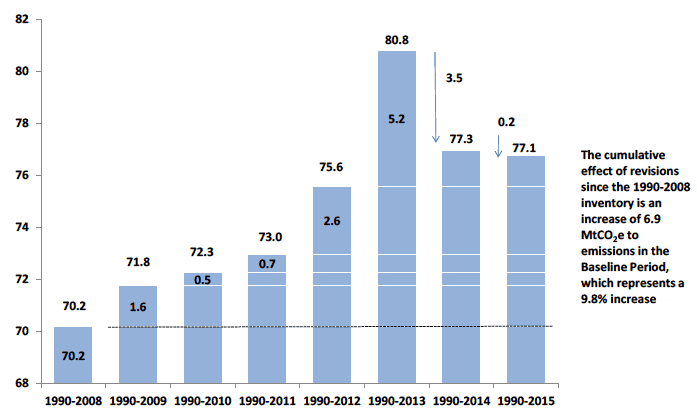
Charts D5 shows the cumulative effect of revisions to the greenhouse gas inventory from 1990-2008 to the latest (1990-2015) inventory across the time series. Chart D6 shows the cumulative effect of revisions to the Baseline from the 1990-2008 inventory, by source sector.
Chart D5. Scottish Greenhouse Gas Emissions, Comparison of 1990-2008 and 1990-2015 Inventories. Values in MtCO 2e
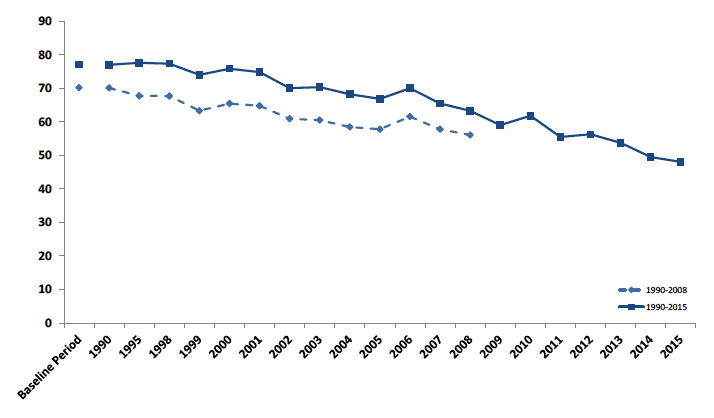
There has been a cumulative upwards revision between 1990-2008 and 1990-2015 across the entire time series.
The emissions in the Baseline have been revised upwards by 6.9 MtCO 2e (9.8 per cent).
Chart D6. Revisions to the Baseline, from the 1990-2008 Inventory to the Latest Inventory (1990-2015), by source sector. Impact of Successive Revisions. Values in MtCO 2e, and percentage changes [17]
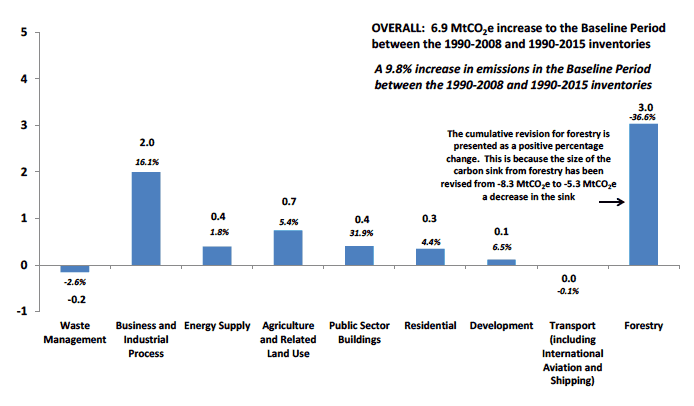
A discussion of the main causes of the upwards revisions between 1990-2008 and the 1990-2013 inventories can be found within the methodology paper: Scottish Greenhouse Gas Emissions 2013. Key Revisions Since 2008.
Contact
There is a problem
Thanks for your feedback